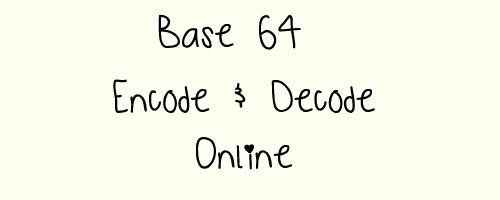

Sending information in binary format can sometimes be risky since not all applications or network systems can handle raw binary. You can use any online text to Base64 converter to verify this result. Using this encoding table we can see that the string "Go win" is encoded as "R28gd2lu" using Base64. Here you can see that decimal 17 corresponds to "R", and decimal 54 corresponds to "2", and so on. These decimal values have been given below: Binary Decimal Now for each chunk above, we have to find its decimal value.
JAVASCRIPT BASE64 DECODE BUFFER FULL
You won't always be able to divide up the data into full sets of 6 bits, in which case you'll have to deal with padding. Note that some implementations of Base64 use different special characters than "+" and "/".Ĭoming back to the example, let us break our 8 bit data into chunks of 6 bits. This is because Base64 format only has 64 characters: 26 uppercase alphabet letters, 26 lowercase alphabet letters, 10 numeric characters, and the "+" and "/" symbols for the new line.īase64 doesn't use all the ASCII special characters, but only these few. However as we said earlier, Base64 converts the data in 8 bit binary form to chunks of 6 bits. You can see here that each character is represented by 8 bits. The first step is to convert this string into binary. Suppose we have a string "Go win" and we want to convert it into a Base64 string. Find the Base64 symbol for each of the decimal values via a Base64 lookup tableįor a better understanding of this concept, let's take a look at an example.Find the decimal version of each of the 6 bit binary chunk.Re-group the 8 bit version of the data into multiple chunks of 6 bits.Calculate the 8 bit binary version of the input text.

Here is how it works for strings of text: How Does Base64 Work?Ĭonverting data to base64 is a multi-step process. In fact, the size of a Base64 encoded piece of information is 1.3333 times the actual size of your original data.īase64 is the most widely used base encoding technique with Base16 and Base32 being the other two commonly used encoding schemes. It is important to mention here that Base64 is not an encryption or compression technique, although it can sometimes be confused as encryption due to the way it seems to obscure data. Internet Explorer 10+ // Define the stringĬonsole.log(encodedString) // Outputs: "SGVsbG8gV29ybGQh"Ĭonsole.Base64 encoding is a way to convert data (typically binary) into the ASCII character set. String += omCharCode(((c & 15) << 12) | ((c2 & 63) << 6) | (c3 & 63)) Īlso, search for "JavaScript base64 encoding" turns up a lot of other options, and the above was the first one. This._keyStr.charAt(enc3) + this._keyStr.charAt(enc4) This._keyStr.charAt(enc1) + this._keyStr.charAt(enc2) + Var chr1, chr2, chr3, enc1, enc2, enc3, enc4 _keyStr : "ABCDEFGHIJKLMNOPQRSTUVWXYZabcdefghijklmnopqrstuvwxyz0123456789+/=", You can probably use both btoa() and atob(), unless you support really outdated browsers. How do I load binary image data using Javascript and XMLHttpRequest?.This does not mean it’s ASCII – presumably if you’re using this function at all, you expect to be working with binary data and not text. This isn’t a problem if you’re actually treating the string as a byte array, but if you’re trying to do something else then you’ll have to encode it first.Ītob() returns a “string” where each character represents an 8-bit byte – that is, its value will be between 0 and 0xff. There appears to be some confusion in the comments regarding what these functions accept/return, so…ītoa() accepts a “string” where each character represents an 8-bit byte – if you pass a string containing characters that can’t be represented in 8 bits, it will probably break. You can use btoa() and atob() to convert to and from base64 encoding.


 0 kommentar(er)
0 kommentar(er)
